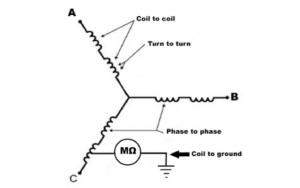Contributor: ALL-TEST Pro LLC
When a de-energized Motor Circuit Analysis (MCA™) motor testing program is first implemented, it is not unusual to have between 10-30% of the motor systems tested to exhibit one or more alarm condition(s) when testing is performed from the output of the motor starter or motor drive. When a motor system is in an alarm condition, this does not necessarily mean that the motor will fail or that it should be stopped immediately, but that the measured values have exceeded pre-determined limits.
One of the first considerations should be motor criticality. Obviously, the most critical motors should be afforded a higher priority than less critical motors. The second consideration is the type and location of the alarm (is it related to the connections, cable, motor winding, etc.?)
It is important to note that a motor system exhibiting an alarm condition should not be automatically condemned or the motor replaced, if the test was performed from the motor control center (output of the motor starter or motor drive). Motor connections and cables between the test point and the motor itself may be the root-cause of the alarm.
Therefore, the next step is to perform another test at the next connection point, whether a disconnect or at the motor itself, with incoming phase leads disconnected. If the alarm condition clears, then the problem is upstream of the test point. If the alarm persists, then it is the motor. Lastly, non-repeatable test results should be considered suspect and investigated further.
With respect to AC induction squirrel-cage rotor motors <1000V, many new motors will exhibit an inductance and impedance imbalance; due to motor design/construction. Therefore, a healthy motor can exhibit an impedance and inductance alarm, even though it is in good condition. Motor Circuit Analysis measurements include impedance and inductance measurements, but phase balance is not used for assessing the condition of the motor windings.
http://test.empoweringpumps.com/all-test-pro-winding-failures-motors/





Comments